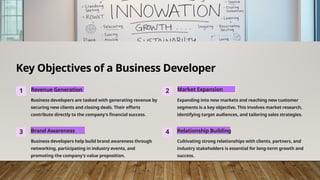business developer role (business session)
- 1. The Role of a Business Developer A business developer is a crucial role within any organization, responsible for driving growth and expanding the company's reach. They are skilled in identifying new opportunities, nurturing relationships with potential clients, and driving sales. by abdelraheem yousif
- 2. Key Objectives of a Business Developer 1 Revenue Generation Business developers are tasked with generating revenue by securing new clients and closing deals. Their efforts contribute directly to the company's financial success. 2 Market Expansion Expanding into new markets and reaching new customer segments is a key objective. This involves market research, identifying target audiences, and tailoring sales strategies. 3 Brand Awareness Business developers help build brand awareness through networking, participating in industry events, and promoting the company's value proposition. 4 Relationship Building Cultivating strong relationships with clients, partners, and industry stakeholders is essential for long-term growth and success.
- 3. Identifying and Targeting Potential Clients Market Research Conducting thorough market research is essential to identify the right target audience for the company's products or services. This involves understanding industry trends, competitor analysis, and customer demographics. Lead Generation Generating leads through various channels like networking events, online platforms, and industry publications is a key step in attracting potential clients. Client Qualification Qualifying potential clients based on their needs, budget, and fit with the company's offerings ensures that sales efforts are focused on high- value prospects.
- 4. Building and Maintaining Strong Client Relationships Communication Effective communication is paramount in building strong relationships. Regularly reaching out to clients, understanding their needs, and addressing their concerns is key. Trust and Transparency Building trust with clients requires honesty and transparency. Providing accurate information, meeting commitments, and being responsive to their needs fosters a strong foundation. Value-Driven Approach Clients need to see the value in the company's offerings. Demonstrating how products or services can solve their problems or meet their goals is essential. Long-Term Focus Building lasting relationships with clients involves a long-term perspective. Providing excellent service and ongoing support builds loyalty and encourages repeat business.
- 5. Developing and Implementing Effective Sales Strategies 1 Define Target Audience Clearly defining the target audience is crucial to tailor sales strategies effectively. Understanding their needs, preferences, and buying behaviors is key. 2 Develop Value Proposition Crafting a compelling value proposition that highlights the benefits of the company's offerings and differentiates them from competitors is essential. 3 Choose Sales Channels Selecting the right sales channels, whether it's direct sales, online marketing, or partnerships, ensures reaching the target audience effectively. 4 Create Sales Materials Developing high-quality sales materials, including brochures, presentations, and proposals, helps communicate the value proposition and engage potential clients. 5 Implement and Track Progress Implementing the sales strategy involves setting goals, tracking progress, and making adjustments as needed to optimize performance.
- 6. Negotiating and Closing Deals Active Listening Understanding the client's needs and priorities is crucial in negotiations. Active listening ensures a clear understanding of their expectations and concerns. Win-Win Approach Negotiations should aim for a win-win outcome. Finding solutions that benefit both parties creates a sense of fairness and fosters long-term relationships. Closing the Deal Successfully closing the deal involves summarizing key points, addressing any remaining questions, and formally agreeing on the terms of the agreement.
- 7. Analyzing and Reporting on Business Performance Metrics Metric Description Importance Sales Revenue Total income generated from sales activities. Measures the overall financial performance of sales efforts. Lead Conversion Rate Percentage of leads that convert into paying customers. Indicates the effectiveness of lead generation and sales processes. Customer Acquisition Cost (CAC) Cost associated with acquiring a new customer. Measures the efficiency of sales and marketing efforts. Customer Lifetime Value (CLTV) Estimated total revenue generated from a single customer over their lifetime. Indicates the profitability of customer relationships.
- 8. Continuously Learning and Adapting to Industry Trends Read Industry Publications Staying updated on industry trends, new technologies, and competitor activities through industry publications provides valuable insights. Attend Industry Events Networking events, conferences, and workshops offer opportunities to learn from experts, connect with peers, and stay abreast of industry developments. Take Online Courses Online courses and training programs provide access to specialized knowledge and skills, enhancing expertise in specific areas. Seek Mentorship Seeking guidance from experienced professionals in the field provides valuable insights, advice, and support in navigating industry challenges.








